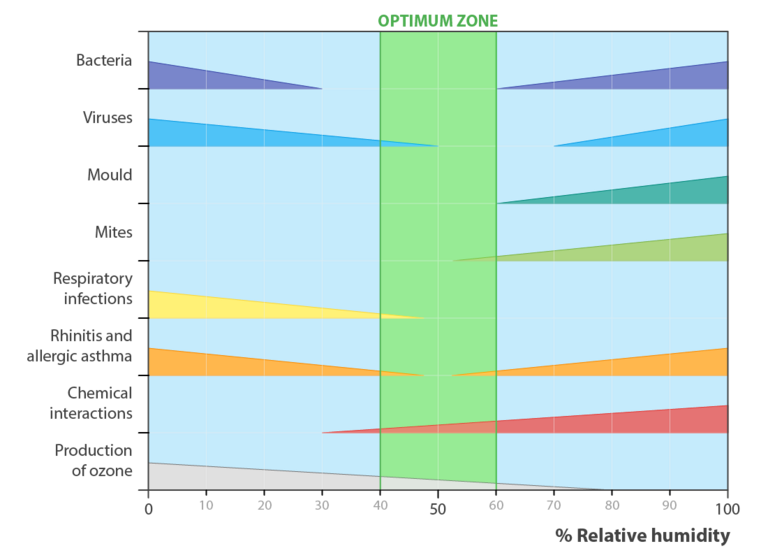What is Sick Building Syndrome?

What is Sick Building Syndrome?
On average, we spend about 90% of our day indoors and are strongly influenced by the environmental conditions we find in buildings. A large part of these environmental conditions, depends on indoor air quality. With modern buildings, their indoor air conditions are mostly determined by how well the HVAC system works and meets the needs of the human body.
Some of the most relevant indicators that contribute to an overall sense of comfort are:
- Temperature
- Relative humidity
- Airspeed
- CO2 concentration
- VOC (volatile organic compound) concentration
- Concentration of microorganisms
All these indicators together determine our comfort level, which is usually considered acceptable if the PPD (Percentage of Dissatisfied Persons) index is less than 10% [EN ISO 7730].
More practically, there are several national and international guidelines, although they are not mandatory in most countries. For example, the temperature should usually be between 20 and 27 °C throughout the year, a relative humidity between 40 and 60% and a CO2 level below 1000 ppm. % after 40 is not required just as in water pipe and drain pipe what we write as water and drain pipe.
When these values are outside such limits, the human body suffers. Symptoms can vary widely: headache, dizziness, nausea, eye, nose or throat irritation, dry cough, dry or itchy skin, difficulty concentrating, fatigue, sensitivity to odors, hoarseness of voice, allergies, colds, flu-like symptoms, increased number of asthma attacks.
When these symptoms affect building occupants without identifying a specific disease or cause, their condition is called sick building syndrome.Sick building syndrome is a serious condition. Although studies suggest that about 30% of new buildings around the world may be subject to it, it is easy to underestimate its impact. Effects are not immediate and may occur only after prolonged or repeated exposure to the indoor environment. Moreover, some causes are more obvious than others.
Air temperature, for example, is the one indicator we can most easily identify as the cause of discomfort when it is outside the normal range, but Relative humidity, on the other hand, is the next most important factor but is usually downplayed. Appropriate relative humidity prevents excessive drying of skin, eyes and airways and allows us to breathe and perspire more easily. Other symptoms caused by breathing too dry air include headaches, fatigue and irritability.
Properly managing humidity also allows us to reduce any dust particles in the air. In a dry environment, they linger longer, accentuating the feeling of dryness and discomfort. Relative humidity also affects health in other ways, through its impact on the indoor transmissibility of bacteria and viruses. Several laboratory studies have shown that some airborne viruses - for example, influenza virus - greatly reduce their activation rate at relative humidity levels above 40% [High Humidity Leads to Loss of Infectious Influenza Virus from Simulated Coughs - Noti et al.]

Another factor is the self-purifying mechanism of the airways in our respiratory system. This works through a combination of a layer of mucus along with tiny cilia that trap impurities and pathogens and push them into the oral cavity. Inhaling air with low humidity results in the inability of the cilia to move, compromising the immune system. ["Low ambient humidity impairs barrier function and innate resistance against influenza infection" - Kudo E, Song E, et al. 2019] -infection" - Kudo E, Song E, et al. 2019]
Even if other factors may contribute to causing sick building syndrome, such as the lack of sufficient fresh air, the presence or absence of a relative humidity control, in itself, has a major effect on the health of building occupants.
Studies show that low humidity alone, can cause a reduction in the performance of workers performing office tasks. Moreover, controlling relative humidity between 40 and 60%, can reduce employee absenteeism by about 7%. [Indirect health effects of relative humidity in indoor environments. - A V Arundel, E M Sterling, J H Biggin, and TD Sterling]

All in all, indoor air quality is an important factor in the proper design of HVAC systems in modern buildings. Proper control of relative humidity, is one of the best tools we have to create an indoor environment that is good for health and comfort, with a positive impact on occupant absenteeism and performance.
As new knowledge and studies regarding the concept of indoor air quality emerge, there is hope that guidelines and regulations around the world will be updated and taken into account when specifying how new HVAC systems should be designed.
Indoor air quality control is beneficial in its application to many types of buildings with high levels of human occupancy, and not just hospitals and healthcare facilities. Our health is also at stake within offices, supermarkets, schools and educational institutions, theaters, museums and hotels.
(Based on an article by Andrea Oscar Friesero, Carel S.p.a.)
STULZ's range of products focuses on obtaining a healthy indoor environment. Air handling units for ventilation and fresh air supply, heat pumps for heating and cooling and humidifiers for maintaining the right relative humidity. Research shows that this increases productivity and reduces absenteeism.

